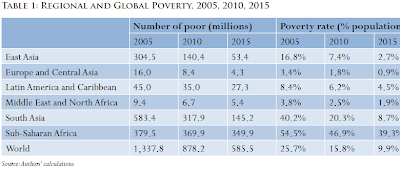Brookings Institute have analyzed the poverty and project there could be fewer than 600 million living on less than $1.25 per day in 2015. In 2009, there were World Bank projections that there would be 1 billion living on less than $1.25 per day in 2015 and 800 million in 2020. Therefore, poverty statistics are catching up to the reality of an improved situation.
The World Bank has a different view, which likely has statistical errors which cause them to overestimate the poverty. Repeat – I believe the World Bank poverty numbers are too high.
Irregardless the trends are matching and by 2020, so long as India, China and Asia do not have sudden and massive economic underperformance there should be very few people living on less than $1.25/day in Asia. This would leave about 350 million people living with less than $1.25/day mainly in Africa. Nigeria is actually doing pretty well economically and is expected to account for 90-100 million of the extremely poor in 2015. If Nigeria continues to do well then they could make a lot of progress against poverty by 2020. A reachable positive scenario is to have less than 200 million living with less than $1.25/day.
It is also conceivable to have less than 1 billion living on less than $2/day in 2020. However, this is a tougher area to make a lot of progress. The reason being is that there are high levels of illiteracy in India and Africa. Someone who is 15 or over now and is illiterate will be 25 or older in 2020 and will be illiterate. India likely has 30-40% illiteracy. Some who are considered literate only have to be able to write their name. This is not true literacy.
PPP $5/day and $10/day standards
$10 to 100/day has been used to define global middle class. Below is an example of rising wealth curves in China with $2/day, $5/day and $10/day cutoffs.
The $2/day, $5/day and $10/day standards will be tough to address without dealing with the literacy problems and without large scale programs for addressing development in India and Africa.
All emerging country urbanization and development are not equal. China’s new cities with high rises, offices and factories and suburbs are not the same as urbanization with a lot of slums and shanty buildings.
China will be able to help the nations that follow with energy efficient, prefabricated high rises (from Broad Group) and exporting low cost nuclear reactors This will help address the quality of emerging country cities and infrastructure. However, India and Africa will have to get serious about anti-poverty, illiteracy and raising the bottom 40%.
What will a mostly middle class and urban world need ?
There will need to be a lot more clean power generation built.
Choices will be made to enable the rise of the global middle class and the escape of billions from poverty. Those who are expecting only solar and wind to be used will be disappointed. Expansion of solar and wind power will occur but the demands for energy will need nuclear and any new innovative energy technology that emerges.
Current world energy consumption statistics are at wikipedia.
The mineral resources will be available but some environmentalists will not like the solutions that will be used to obtain the needed minerals. Resources will be obtained from the ocean and the ocean floor and from innovation extraction of resources on land.
Food production will need to be expanded.
By 2050 the world’s population will reach 9.1 billion, 34 percent higher than today. Nearly all of this population increase will occur in developing countries. Urbanization will continue at an accelerated pace, and about 70 percent of the world’s population will be urban (compared to 49 percent today). Income levels will be many multiples of what they are now. In order to feed this larger, more urban and richer population, food production (net of food used for biofuels) must increase by 70 percent. Annual cereal production will need to rise to about 3 billion tonnes from 2.1 billion today and annual meat production will need to rise by over 200 million tonnes to reach 470 million tonnes.
There will be continued expansion of fish farming and genetic engineering of crops and animals.
If you liked this article, please give it a quick review on ycombinator or StumbleUpon. Thanks

Brian Wang is a Futurist Thought Leader and a popular Science blogger with 1 million readers per month. His blog Nextbigfuture.com is ranked #1 Science News Blog. It covers many disruptive technology and trends including Space, Robotics, Artificial Intelligence, Medicine, Anti-aging Biotechnology, and Nanotechnology.
Known for identifying cutting edge technologies, he is currently a Co-Founder of a startup and fundraiser for high potential early-stage companies. He is the Head of Research for Allocations for deep technology investments and an Angel Investor at Space Angels.
A frequent speaker at corporations, he has been a TEDx speaker, a Singularity University speaker and guest at numerous interviews for radio and podcasts. He is open to public speaking and advising engagements.






